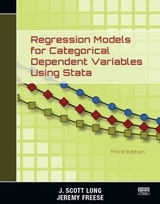
Regression Models for Categorical Dependent Variables Using Stata, Second Edition
Stata Press (Verlag)
978-1-59718-011-5 (ISBN)
- Titel erscheint in neuer Auflage
- Artikel merken
Although regression models for categorical dependent variables are common, few texts explain how to interpret such models. Regression Models for Categorical Dependent Variables Using Stata, Second Edition, fills this void, showing how to fit and interpret regression models for categorical data with Stata. The authors also provide a suite of commands for hypothesis testing and model diagnostics to accompany the book.
The book begins with an excellent introduction to Stata and then provides a general treatment of estimation, testing, fit, and interpretation in this class of models. It covers in detail binary, ordinal, nominal, and count outcomes in separate chapters. The final chapter discusses how to fit and interpret models with special characteristics, such as ordinal and nominal independent variables, interaction, and nonlinear terms. One appendix discusses the syntax of the author-written commands, and a second gives details of the datasets used by the authors in the book.
Nearly 50% longer than the previous edition, the book covers new topics for fitting and interpreting models included in Stata 9, such as multinomial probit models, the stereotype logistic model, and zero-truncated count models. Many of the interpretation techniques have been updated to include interval as well as point estimates.
New to the Second Edition:
Regression models, including the zero-truncated Poisson and the zero-truncated negative binomial models, the hurdle model for counts, the stereotype logistic regression model, the rank-ordered logit model, and the multinomial probit model
Stata commands, such as estat, which provides a uniform way to access statistics useful for postestimation interpretation.
Expanded suite of programs known as SPost
Inclusion of confidence intervals for predictions computed by prvalue and prgen
Because all the examples, datasets, and author-written commands are available from the authors' Web site, readers can easily replicate the concrete examples using Stata, making it ideal for students or applied researchers who want to know how to fit and interpret models for categorical data.
Preface
PART I GENERAL INFORMATION
Introduction
What is this book about?
Which models are considered?
Whom is this book for?
How is the book organized?
What software do you need?
Where can I learn more about the models?
Introduction to Stata
The Stata interface
Abbreviations
How to get help
The working directory
Stata file types
Saving output to log files
Using and saving datasets
Size limitations on datasets
Do-files
Using Stata for serious data analysis
Syntax of Stata commands
Managing data
Creating new variables
Labeling variables and values
Global and local macros
Graphics
A brief tutorial
Estimation, Testing, Fit, and Interpretation
Estimation
Postestimation analysis
Testing
estat command
Measures of fit
Interpretation
Confidence intervals for prediction
Next steps
PART II MODELS FOR SPECIFIC KINDS OF OUTCOMES
Models for Binary Outcomes
The statistical model
Estimation using logit and probit
Hypothesis testing with test and lrtest
Residuals and influence using predict
Measuring fit
Interpretation using predicted values
Interpretation using odds ratios with listcoef
Other commands for binary outcomes
Models for Ordinal Outcomes
The statistical model
Estimation using ologit and oprobit
Hypothesis testing with test and lrtest
Scalar measures of fit using fitstat
Converting to a different parameterization
The parallel regression assumption
Residuals and outliers using predict
Interpretation
Less common models for ordinal outcomes
Models for Nominal Outcomes with Case-Specific Data
The multinomial logit model
Estimation using mlogit
Hypothesis testing of coefficients
Independence of irrelevant alternatives
Measures of fit
Interpretation
Multinomial probit model with IIA
Stereotype logistic regression
Models for Nominal Outcomes with Alternative-Specific Data
Alternative-specific data organization
The conditional logit model
Alternative-specific multinomial probit
The sturctural covariance matrix
Rank-ordered logistic regression
Conclusions
Models for Count Outcomes
The Poisson distribution
The Poisson regression model
The negative binomial regression model
Models for truncated counts
The hurdle regression model
Zero-inflated count models
Comparisons among count models
Using countfit to compare count models
More Topics
Ordinal and nominal independent variables
Interactions
Nonlinear models
Using praccum and forvalues to plot predictions
Extending SPost to other estimation commands
Using Stata more efficiently
Conclusions
Appendix A Syntax for SPost Commands
Appendix B Description of Datasets
References
Author Index
Subject Index
| Erscheint lt. Verlag | 15.11.2005 |
|---|---|
| Verlagsort | College Station |
| Sprache | englisch |
| Gewicht | 1111 g |
| Themenwelt | Mathematik / Informatik ► Mathematik |
| ISBN-10 | 1-59718-011-4 / 1597180114 |
| ISBN-13 | 978-1-59718-011-5 / 9781597180115 |
| Zustand | Neuware |
| Haben Sie eine Frage zum Produkt? |
aus dem Bereich



